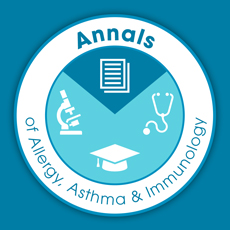 By now, all of you should have received your September issue of the Annals of Allergy, Asthma and Immunology. While our monthly emphasis has been in pharmacoeconomics, I want to be sure you have looked at some of our other features in this issue. I would like to call your attention to two, in particular.
By now, all of you should have received your September issue of the Annals of Allergy, Asthma and Immunology. While our monthly emphasis has been in pharmacoeconomics, I want to be sure you have looked at some of our other features in this issue. I would like to call your attention to two, in particular.
First is a study by Catherine Kessler, PhD and colleagues examining whether the use of injectable epinephrine was affected by specific available device. Despite the importance of prompt epinephrine auto-injector treatment during anaphylaxis, proper administration technique is often lacking among patients and caregivers. The study compares usability and participant preference of two different devices in a simulated life-threatening allergic emergency-use scenario. Previously untrained adults were tasked with using two different trainers to simulate epinephrine administration to a child-sized manikin. The primary endpoint was completing injection tasks per device instructions. There were statistically significant differences in completing the task, accompanied by differences in preference. The importance of this study is not an endorsement of one device over another, but that design differences may have great importance in successful epinephrine administration during a life-threatening allergic emergency.
Don’t miss out on these other great articles from Annals:
- Immunological changes associated with the onset of atopic dermatitis and a primer on cost effectiveness in the allergy clinic
- Reviewing comorbidities associated with atopic dermatitis and management of chronic pruritis
- Evidence for using point-of-care ultrasonography as a clinical office tool, the venom immunotherapy shortages as an example of payment structure of medical services, and value of the ABAI MOC program
Another article of interest is a bit unusual for the Annals. We rarely publish animal model studies, except where they make a very specific clinical point. Such is a manuscript by Yoshihisa Tokunaga, MD and colleagues who studied the prevalence of CD163+ macrophages in lung tissue from patients who had fatal asthma attacks and further studied these cells in a CD163 knockout mouse model using classic ovalbumin-sensitized murine asthma. Their results indicated a significant biological role for these CD163+ macrophages and could have potential as a possible biomarker for certain asthma phenotypes and endotypes. Be sure to read the accompanying editorial by Jonathan Tam, MD, FACAAI that really puts the report into good perspective. If learning about new phenotypes and endotypes interests you as a basis for existing and new directed therapies, then this paper is a must-read for you.
I hope your fall is progressing well (we just passed the equinox, so days are getting shorter). It will only be a few more weeks before the Annual Meeting, and I hope to see many of you in Houston. Feel free to stop me and share your thoughts about the Annals. We are constantly looking for ways to improve our journal for you, our readers.
Gailen D. Marshall, Jr., MD PhD, FACAAI
Editor-in-chief

